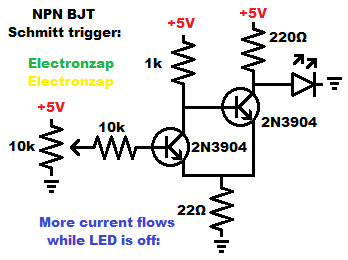Table of Contents
A lone NPN Bipolar Junction Transistor BJT does not turn on and off quickly when the signal is slowly moving past approx. 0.6V.
By combining 2 NPN BJTs however, you can make a Schmitt trigger with an inverted output circuit. A high enough input voltage, gives a low output. A low enough input signal voltage, gives a higher voltage output.

2 NPN BJTs Wired as a Schmitt trigger…
- If the left NPN transistor is off. Current flows through 1K resistor and turns the right NPN BJT on. The LED will be off fully.
- Once the left NPN BJT starts conducting, it equalizes the voltage across the right NPN BJTs base and emitter. Turning it off suddenly. The LED lights up through the 220Ω resistor.
- The left NPN BJT has to turn off completely for the right NPN BJT to turn on again.
- Whichever NPN BJT is conducting at a given time, makes it harder for the other NPN BJT to start conducting.
- The signal doesn’t have a single point where it changes the output (LED) state.
- There is a middle ground voltage region, where the output stays in the last state that it was put into.
- That middle ground voltage region is called hysteresis.
- A Schmitt trigger is a switch with hysteresis.
Video:
To support this site, check out the following links:
- Become a Patron!
- Check out my YouTube videos! https://www.youtube.com/c/Electronzap/videos
- Products I used in my videos or otherwise think look like a good buy. As an Amazon associate, I earn from qualifying purchases. https://www.amazon.com/shop/electronzapdotcom
- Information on this site is not guaranteed to be accurate. Always consult the manufacturer info/datasheet of parts you use. Research the proper safety precautions for everything you do.
- Electronzap is a participant in the Amazon Services LLC Associates Program, an affiliate advertising program designed to provide a means for sites to earn advertising fees by advertising and linking to amazon.com.